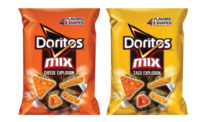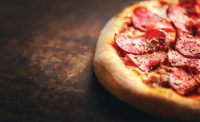As noted in our June 2019 SF&WB “State of the Industry: Bakery” coverage, desserts categories at retail are seeing mixed results. One bright spot was refrigerated cheesecakes, a category that grew by 4.5 percent in dollar sales to $320.5 million for the 52 weeks ending March 24, 2019, per IRI, Chicago. Cookies also saw an increase for the year, up 2.6 percent to $8.8 billion. And frozen cookies—while still a very small niche—saw a considerable jump. But shelf-stable pies and cakes, collectively valued at $1.9 billion for the year, dropped 5.1 percent, and refrigerated and frozen segments likewise saw decreases.
Product developers have a wide range of opportunities to infuse new life into historically indulgent categories like pies, cakes, cheesecakes and cookies. These strategies include factoring in increasingly mainstream dietary specializations during ideation, considering slight nutritional improvements that don’t sacrifice flavor and indulgent appeal, adding single-serve and customized options, and exploring high-culinary flavor trends of note.
Mainstreamed specializations
Formerly specialized dietary options increasingly factor into mainstream bakery trends.
For instance, Peggy Castaldi, director of marketing, SupHerb Farms, Turlock, CA, points toward vegan, plant-based desserts like cakes, often made with less added sugar. “In a word, healthier. What all this means is that enhancing flavor becomes a top priority, as most consumers only want healthier food if it tastes good. Additionally, most products with sugar substitutes taste different than those with real sugar.” She notes that savory flavors can help minimize or eliminate the flavor difference.
“Retail desserts have been trending toward overarching consumer trends like free-from and plant-based dietary habits,” says Harbinder Maan, associate director of trade marketing and stewardship, Almond Board of California, Modesto, CA. “Consumers are increasingly looking for gluten-free and dairy-free product introductions in retail desserts, and demand for creative vegan desserts has consistently risen.” She notes that according to a recent Innova Market Insights report, gluten-free was the top almond claim in the bakery category, and within the cookies category, vegan products incorporating almonds increased 79 percent between 2013 and 2017.
“Catering to special diets such as gluten-free, non-dairy, vegan and even keto are becoming more prevalent in retail desserts,” says Christina Kaelberer, executive pastry chef and general manager, Edwards Dessert Kitchen, Minneapolis, and a member of the Schwan’s Chef Collective.
“Today’s consumer is more discerning than ever,” says Kaelberer. The indulgence must be worth it. “With this in mind, our take on the classic chocolate chip cookie at Edwards Dessert Kitchen is made with highest-quality chocolate, salted butter and our own flour blend that delivers an a amazing cookie that is also gluten-free.”
Jeff Smith, director of marketing, Blue Diamond Almonds Global Ingredients Division, Sacramento, CA, suggests that for foodservice desserts, almonds allow for the “best of both worlds” when it comes to indulgent dessert offerings that don’t compromise on potential dietary restrictions. “Blue Diamond’s Almond Protein Powder is perfectly aligned with the trend toward functional and enhanced bakery products,” he says, noting that the ingredient can be blended with almond flour to create fortified versions of popular baked dessert items, such as cookies and brownies, including non-GMO, dairy-free, soy-free and gluten-free formulations.
Incrementally better-for-you
“Consumers are pivoting toward simple, unprocessed, clean-label foods, and many are increasingly looking for better-for-you versions of their favorite sweets and desserts,” says Smith. This means incorporating more natural, clean-label, inherently nutritious ingredients into dessert products.
“Whether used as inclusions in cookies or bars, or within fillings for cakes or pies, or as a topping for cheesecakes, almonds are a versatile, all-natural ingredient that enhances product flavor and provides important nutrition,” says Smith. He notes that almonds come in so many forms—from sliced, diced, slivered and split, to almond butter and almond flour—that they can serve as a topping, inclusion or filling in cakes, pies, cheesecakes and other desserts.
Some ingredients immediately capture attention through a burst of vibrant color—often nodding to the nutritional cachet they bring to the application. “Product designers are meeting demand for ‘good, healthy ingredients’ in their products by including blueberries in desserts and treats,” says Tom Payne, industry consultant to the U.S. Highbush Blueberry Council, San Mateo, CA. He suggests that dessert developers can use blueberry purées in cakes to help boost their wholesome, nutritional appeal.
Chocolate is also a natural pairing with blueberries. “Chocolate makers have gotten on the antioxidant bandwagon, touting good health as another plus,” says Payne. Adding blueberries can boost that impact. “Blueberries and dark chocolate co-star in cookies, pastries and cheesecakes. Blueberries provide an acidic note that adds the perfect accent to rich desserts, chocolate and otherwise. The blueberry image is used to imbue products with a virtuous and planet-friendly aura.”
Payne notes that the U.S. Highbush Blueberry Council provides the Real Blueberries Seal to clearly identify products that feature authentic blueberries (see www.realblueberries.org).
“Today’s consumers are much more educated about healthy ingredients,” says Elizabeth Ortiz, marketing specialist, Boston Baking, Inc., Boston. “Pie, for example, is slowly leaving the seasonal-only category and becoming more of a year-round dessert option.” Pies, she notes, can easily be made with clean ingredients while remaining perfectly indulgent. In order to make a flexible rotation of pies easier to facilitate, Boston Baking has been improving its pie shell formulations so foodservice providers and retailers can easily create pies that fit consumer needs.
“Ingredient selection can go a long way in broadening appeal for desserts,” says Frank Flider, oils expert, QUALISOY, Chesterfield, MO. “Flavor, mouthfeel, aroma and freshness are important when assessing the quality of a dessert. A perfect example is pie—ideally, the crust is crispy and firm, and not soggy.” The right shortening or oil can be the difference between a pie that tastes homemade versus one that comes across as mass-produced, he suggests, noting that high-oleic soybean shortening is a drop-in alternative to partially hydrogenated shortenings, matching performance metrics in many dessert applications.
“The proper shortening also allows for uniformly risen cakes, moist mouthfeel and optimum flavor release,” says Flider.
A consistent theme here is natural. “Food transparency and the use of natural ingredients have continued on an upward trend,” says Jennifer Williams, marketing director, domestic, California Walnut Board and Commission, Folsom, CA. “Food manufacturers and dessert makers are focusing new product development on desserts that can be considered both healthful and indulgent.” A primary strategy is to opt for only all-natural ingredients, such as real chocolate, fruits, walnuts and whole wheat flour—staples that are familiar to consumers.
In these desserts, manufacturers are seeking to create more-healthful products without sacrificing the indulgent nature of desserts, notes Williams. She suggests that the sweet, mild taste of walnuts complements both sweet and savory dessert applications.
“In addition to formulating clean-label desserts, we’re also seeing dessert manufacturers modify existing formats to make them more calorie-friendly to consumers,” says Williams. “For example, cookie manufacturers are launching ‘thin’ or ‘crispy’ versions of their favorite cookies to provide a serving size that’s more in line with a healthy diet. These cookies can use walnuts to maintain their premium position and impart indulgence, even in a product that’s smaller in portion size.”
Research shows that individualized packaging and single-serve offerings are driving new growth in cake, pie and cheesecake categories, says Smith. Mintel has reported that 28 percent of U.S. cake and pie users feel that individual portion sizes would influence them to purchase more ready-to-eat cakes or pies. “Single-serve portions also increase convenience and portability, ideal for the increasing number of busy consumers who are on-the-go,” he says, noting that a 2017 Technomic survey found that consumers are increasingly accepting dessert as an anytime option.
Kristen Boschetto, vice president of sales and owner, Boston Baking, notes a prevailing trend toward “quality versus quantity,” suggesting that decadent, single-serve treats allow consumers to conveniently indulge at any time during the day.
Emerging opportunities
Customization of a fresh selection of single-serve items in the in-store bakery (ISB) can help build interest, suggests Boschetto. “We have assisted ISBs and retailers by providing components, such as whoopie and cupcake blanks, Bundt cakes and more, that allow them to create unique treats that their customers would enjoy.”
Single-serve cakes and pies continue to be a trend that allow personalization of individual indulgences, says Pete Thomsen, director of sales and strategy, Sugar Bowl Bakery, Hayward, CA. Ethnic, regional and seasonal flavors, such as pumpkin spice, in the fall can also prove popular. He notes that traditional favorites can see an update via ethnic or regional twist, such as sweet tea baklava or funfetti churro.
Thomsen suggests a method for discovering flavor/format trends in products merchandised across the ISB. Retailers could provide a range of dessert choices in different flavors, textures and even for specific dietary requirements, and then track what sells well for potential translation expansion into a dedicated packaged line for wider center-store merchandising. “This is how Coca-Cola decided to launch an orange vanilla flavor,” he says, noting that the beverage maker had discovered that it was a top selection in its Freestyle fountain dispensing machines.
Sometimes, seemingly offbeat tactics can click. “For foodservice applications, the ‘breakfast-as-dessert’ trend has been exploring the clafoutis/pancake/waffle realm, bringing blueberries together with herb-steeped syrups and the inviting crunch of roasted nuts,” says Payne. “Blueberries give such indulgences a comfort-food permit.”
Mark Pappas, culinary scientist, Culinary Focus/The Spice Guild, Irving, TX, notes that he’s seeing more build-your-own kits for desserts at retail that include all necessary ingredients. “Dessert empanadas are another major trend we’re seeing with fruit like raspberries.”
Desserts can also build interest by using savory ingredients, and even traditionally savory food formats that are sweetened as a base, such as a feta, honey and raspberry flatbread. He also notes that dessert “appetizers” support portion control and encourage sampling.
Desserts for foodservice sometimes gain an edge by promoting details about specific ingredients, suggests Williams, such as by naming the source of origin of the chocolate or something specific about the supplier to evoke the terroir of the ingredient. “Food manufacturers in the dessert aisle can benefit from adapting some of these practices when they use an ingredient with a strong source, such as walnuts from California,” she says.
There’s power in a sense of place. “Global flavors have played well for the last couple of years and will continue to do so as the world becomes more connected,” says Williams.
“In my career as a pastry chef, I’ve always loved exploring how global flavors and savory notes can add interest to desserts, such as our Mole Spice Brownie, which features Mexican mole spice as a flavor complement to chocolate, or our Curried Scotcheroo, which adds curry to the classic peanut butter, chocolate, rice-crisp ‘church basement’ dessert bar to bring a surprising and delicious ‘wow’ factor,” says Kaelberer.
Williams also notes that more foodservice and retail desserts are highlighting flavors taken from popular cocktails or spirits, such as bourbon. “Floral flavors such as hibiscus and orange blossom also are appearing in products due to consumer cravings for more natural flavor profiles.”
Fruity flavors paired with mint or floral notes, such as blueberry-mojito or herb-blueberry-tea profiles, can serve as a flavor base for desserts, suggests Payne. “Blueberry works well in flavor combinations with spices, botanicals, citrus and herbs because blueberries complement and enhance, as well as balance, flavors.”
And a bit of heat isn’t completely foreign to the dessert realm. “I expect to see more spicy desserts in the future,” says Castaldi. “This includes not only peppers in desserts, but ingredients such as ginger.”
Herbs and fruit are a great combination, seen today in some frozen desserts, says Castaldi. “This is another trend that can easily be transferred to pies and cheesecakes for a savory, ethnic twist. Citrus flavors can be enhanced with ginger, turmeric and basil, or with peppers for a touch of heat. Why not redefine a fruit or key lime pie with a complementary herb, spice or chile pepper?”
The Hershey Foodservice Culinary Team reports that its test kitchen is currently developing recipes with lavender, Earl Grey, passionfruit and beet flavor profiles for cakes, cheesecakes and cookies, among other indulgent offerings.
That said, the Hershey Foodservice Culinary Team notes that chocolate is still tops when it comes to desserts. Also, when it comes to trendy flavors, they note that consumers can often teeter on the edge of decision-making, hesitant to branch out when making dessert choices. That’s why taking modern ingredients, like fig and balsamic, and pairing them with chocolate, a safe and nostalgic dessert flavor, helps give them a sense of security to try new options.








